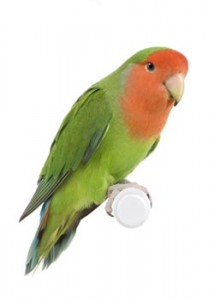Contents

We enjoy our companion birds, often without thinking about their very special characteristics. Parrots are structured to survive as flying, flocking, feathered denizens of the sky and trees. They are adapted for a very different environment than us ground-dwellers or even our furry canine and feline companions.
1. Nibbling on Hot Peppers
It’s amazing to watch a parrot calmly nibble on a hot pepper for a snack. People have 9,000 taste buds, while parrots have 350. A parrot’s sense of smell is also less acute. While it’s not known exactly which of these factors plays a part in it, parrots don’t have the same reaction that we have when eating a hot pepper. There are numerous nutritional benefits to peppers, and dried ones are often found in parrot food mixes.
Tip to Use This Info: Since peppers are a good snack for parrots, include some fresh ones, never mind the heat index, on a kabob or in a bowl mixed with fresh veggies for your bird to shred for entertainment and eat as a low-calorie snack. Peppers come in a variety of shapes and colors.
2. Built for Flight
Birds are built to be active and to fly. That’s something we grounded humans marvel at. Parrot’s skeleton consist of hollow bones, with reinforcement that make them strong but still light. A parrot’s skull is quite lightweight and, instead of a jaw and teeth to chew, a bird has a lightweight beak. Its food is ground in a gizzard and processed for digestion.
Birds are also kept warm by their lightweight covering of feathers, which offer ample insulation and assist in flight. People appreciate how efficiently feathers insulate and keep a body warm – that’s why we use them in down coats and down comforters.
Should You Trim Your Pet Bird’s Flight Feathers?: Bird flight is sometimes problematic in a household where a pet bird might fly too fast into a window or might range too freely in a house. On the other hand, flight is a natural form of exercise for birds. We can curtail flight, while still allowing a bird to glide and land for a few months at a time by trimming a few of a parrot’s flight feathers. Those feathers will re-grow in 6 months to a year (or sooner for some species like cockatiels), and you will make the decision again whether or not to trim the feathers.
Should you have your birds wing feathers clipped? There are many factors to consider, from a bird’s ability to get away from a dog or cat in the house to the bird’s level of target/recall training, to the layout of the area in the home the bird is housed in.
3. Digestion
Parrots have a crop and a gizzard, two pieces of anatomy you won’t find on mammals. The crop serves to store food. If a parrot hits a windfall of food, that’s a way to eat more than he needs and have some for later. The crop is a muscular pouch near the throat, a part of the esophagus. The crop softens food, which moves along the digestive system from there to the gizzard to be processed. The gizzard performs the function that chewing does in mammals. It does so without heavy apparatus — teeth — up front that would not be very aerodynamic. When your bird uses his crop for storage, it will be very visible. If you’ve seen featherless parrot chicks, you know that in those early stages the crop is an important part of the anatomy! Some parrots look like they are half crop and half body when they’re very young.
4. Water-Proofed Exteriors
Birds spend a great deal of time caring for their feathers. They preen their feathers by taking oil from a gland at the base of their tail and spreading it on each feather. This gives them a clean, warm, waterproof exterior. Some birds have down feathers beneath their exterior feathers (cockatoos and cockatiels, for example) to provide extra warmth. These feathers disintegrate and make those species dusty ones to keep.
Behavior Note: Encourage your pet parrot to preen by offering it a shower at least once a week, or by taking him into the bathroom when you shower, where the steam produced is good for his feathers. There are shower perches available so your bird can come in with you and have a safe place to perch.
Tip: Changes in feather quality can signal illness. If your bird’s feathers are dull, grow in a different color from normal or have patterns of bars on them, have the parrot checked out by an avian veterinarian. Bird feathers are a rare external indication of bird illness or malnutrition.
5. Extensive Respiratory Systems
Mammals have two lungs that expand and contract. Birds have small, stationary lungs and a diaphragm that does not move, with an extensive set of air sacs to complete their respiratory system. Parrots also use their respiratory system to help regulate their body heat, and some air sacs extend into those light, hollow bones.
Tip: With a respiratory system that extends throughout their body, parrots are sensitive to fumes and smoke. Minimize exposure to these in a bird’s environment.





